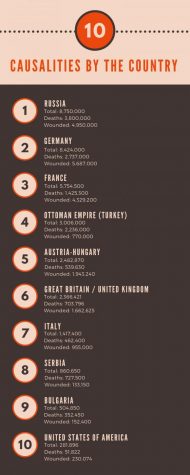The History of the Armistice
You’ve probably heard someone say, “It’s 11:11, make a wish!” The number 11 is supposed to be lucky. To the soldiers fighting in World War I, it was.
World War I began in 1914 following the assassination of Archduke Franz Ferdinand, the heir to the Austria-Hungarian throne, according to Robert Green’s book, World War I. Austria-Hungary declared war on Serbia (where the assassins were from), and their allies were pulled into the fight. This began the Great War, initially only involving Eurasian countries.
The war raged on, involving more and more countries. The United States, under Woodrow Wilson’s presidency, chose to remain neutral for three years. They provided weapons, equipment, and other supplies to both sides of the war—the Allies and the Central Powers.
Following the sinking of a passenger ship, the RMS Lusitania, and the Zimmerman Telegram, citizens of the United States pushed Woodrow Wilson to join the war. He met with Congress to request a declaration of war. According to Stewart Ross’s book, World War I, Congress agreed on April 6, 1917. The United States was now involved in the war.
The United States joined the war opposing Austria-Hungary and Germany. The U.S. sided with the Allies, which included Great Britain, France, Serbia, Italy, and Russia (before they withdrew from the war).
A little over a year later, the Central Powers were starting to crumble. According to Green, the Austrians surrendered to the Italians, the Hungarians dissociated themselves from Austria, and the Allies moved in on Germany. The German army held strong, but Kaiser Wilhelm II didn’t.
On November 10, 1918, the last emperor of Germany fled to the Netherlands, according to Green. The remaining government of Germany met with the Allies the following day.

“At 11 a.m. on November 11, 1918, Germany and the Allies signed an armistice that brought all hostilities to an end,” Stewart Ross wrote in his book, World War I.
November 11 became known as Armistice Day and was celebrated as marking the end of the Great War. Peace conferences began in January of the following year, 1919. In these conferences, President Wilson proposed his Fourteen Points, which included an international peacekeeping organization, the League of Nations.
The terms of the Treaty of Versailles and other treaties signed following the end of World War I were humiliating for the losing side, according to Ross. These humiliating terms led to World War II twenty years later, where the United States was pulled into the war again once it was in full swing.
Wars that followed World War I included the second World War, the Korean War, and the Vietnam War, among others. Within these wars, many lives were lost. This is why Armistice Day would eventually become known as Veterans’ Day. It still falls on November 11, but now it serves as a day to remember soldiers that lost their lives in the wars, as well as men and women currently serving.
November 11, 2018 marks a hundred years since the signing of the armistice. Around the world, countries held events to honor the end of World War I and those that died fighting in it. In Washington D.C., there was a parade celebrating the hundred years that have passed since the Great War ended.
The signing of the armistice meant an end to bloody battles, where soldiers risked their lives living in muddy trenches. At 11 a.m. on November 11, the bloody battles ceased. The soldiers could leave the war behind, returning to being civilians instead. Maybe the end to the war was their 11:11 wish.

Deanna Grove is a senior at James Buchanan High School. This is her first year as part of the JB Student Media staff, and she's always busy taking part...
















